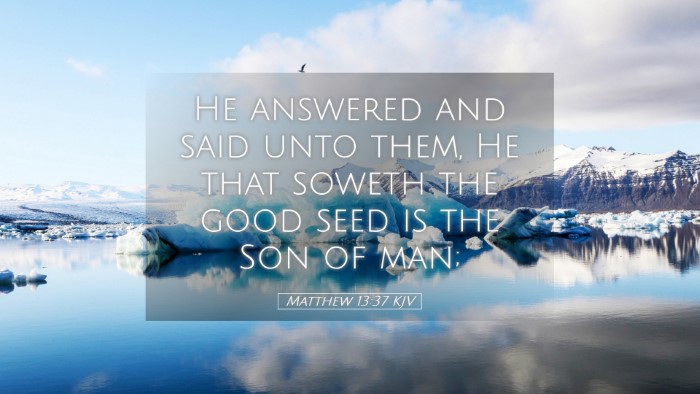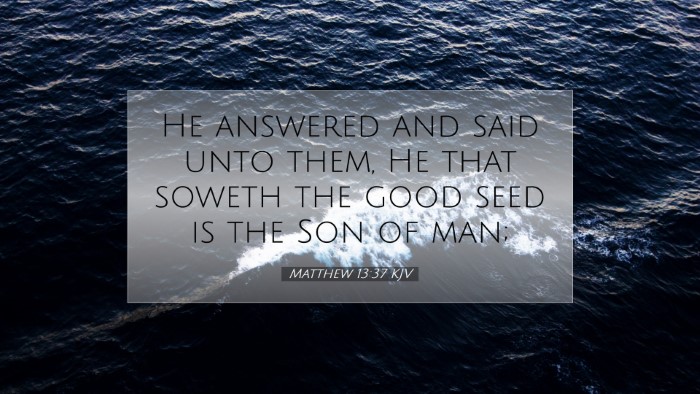Commentary on Matthew 13:37
Verse: "He answered and said unto them, He that soweth the good seed is the Son of man."
Overview
Matthew 13:37 is found within the context of Jesus's parable of the wheat and the tares, a profound teaching that illustrates the spiritual reality of the kingdom of heaven. This verse highlights the identity of the sower, who is identified as the "Son of man," a title that Jesus frequently used for Himself, emphasizing both His humanity and His divine mission.
Contextual Background
- The Parable of the Wheat and Tares: This parable (Matthew 13:24-30) contrasts the kingdom of heaven with the world, illustrating the coexistence of good and evil until the final judgment.
- Understanding the Sower: Jesus identifies Himself as the one who sows good seed, symbolizing the truth and righteousness that He brings to humanity.
- The Audience: Jesus spoke to a diverse audience, which included His disciples and the multitudes, each receiving this teaching at different levels of understanding.
Insights from Public Domain Commentaries
Matthew Henry
Matthew Henry highlights how in this parable, the “good seed” represents those who are the children of the kingdom. The emphasis on the sower being the "Son of man" captures Christ's role as the initiator of God's redemptive plan. Henry stresses the importance of recognizing that the sowing of good seed is a divine endeavor, where Christ is actively involved in imparting truth to the hearts of people. He notes that this sowing is not a mere historical event but an ongoing activity as Christ continues to influence the lives of believers through His teachings.
Albert Barnes
Albert Barnes elaborates on the metaphor of the sower in his commentary, underscoring that the term "son of man" speaks to Jesus's humility and connection to humanity. He asserts that Jesus, as the sower, is both the source and embodiment of the word of God. Barnes explains that this verse encapsulates the essence of evangelism and planting seeds of faith in the hearts of individuals. He further asserts that recognizing who the sower is provides deep theological insight into Christ's nature — He is both divine and anthropomorphic, bridging the gap between heaven and earth.
Adam Clarke
Adam Clarke provides a nuanced analysis of the use of the phrase "good seed." He emphasizes that this seed represents the gospel message, which can bring forth eternal life. Clarke explains that by stating He is the "Son of man," Jesus affirms His mission to redeem humanity. This earthly title reflects His approachability and His desire to engage with the human experience. Clarke also points out that understanding the identity of the sower is crucial for interpreting the subsequent events in the parable, where the presence of tares represents the intrusion of evil in a world created by God for good.
Theological Implications
- The Sovereignty of Christ: This verse underscores Jesus’ sovereignty in planting good within His creation, demonstrating God’s purposeful design in the existence of faith amidst adversity.
- Hope in the Harvest: The assurance that good seed has been sown entails hope for a future harvest, where righteousness will be ultimately triumphant over evil.
- Role of Believers: Believers are encouraged to see themselves as partners in the sowing process, participating in God’s mission by spreading the gospel message.
Application for Pastors and Theologians
For pastors, the insights from Matthew 13:37 remind them of the importance of faithfully sowing the good seed in their communities. Understanding that they are part of a larger divine plan motivates them to engage in evangelism, discipleship, and nurturing a faith community. The clear distinction between the good seed and the tares is also an invitation for pastoral reflection on the challenges of maintaining purity and integrity within the church.
For students and scholars, this verse offers significant theological depth regarding Christ’s nature and mission. Engaging with the various commentaries highlights the multifaceted understanding of Jesus's role as the definite sower and fosters a deeper appreciation for the complexities of the kingdom of heaven. In scholarly research, these insights can lead to further exploration of the relationship between the sower (Christ), the seed (His message), and human reception.
Conclusion
Matthew 13:37 serves as a pivotal verse that encapsulates Christ's identity and His redemptive mission. Drawing from the rich insights of Matthew Henry, Albert Barnes, and Adam Clarke, we see the multifaceted nature of this simple yet profound statement. It calls believers to recognize Christ's active role in the world while also challenging them to participate in the ongoing work of sowing good seed. As we reflect on this verse, may we find renewed purpose in sharing the gospel and nurturing the growth of the kingdom of heaven on earth.


